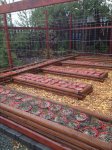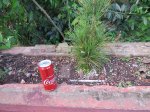Sacrifice branches “off to the side” don’t do much. Terminal (apex) sacrifice trunks do.
The way it’s done is find a place with three branches at a node, or reduce branches down to three. Select one to be a future branch. Select another to be the future trunk. The remaining branch will be the sacrifice trunk. Stake it up vertical. Plant the tree in the ground. Let the sacrifice branch grow unimpeded. Keep the future branch cut back and decandle it. Let the future trunk grow a little, but don’t let it get long and lanky. Make sure the sacrifice does not shade out the future branch and trunk.
After a year or so, remove the sacrifice. Look for another node on the “future trunk” branch, and repeat the process.
Repeat until you’re happy with the trunk. Then really start working on the branches. The idea is to keep the branches small while building trunk with the sacrifices.
Here’s an example of a tree developed that way:
View attachment 167893



